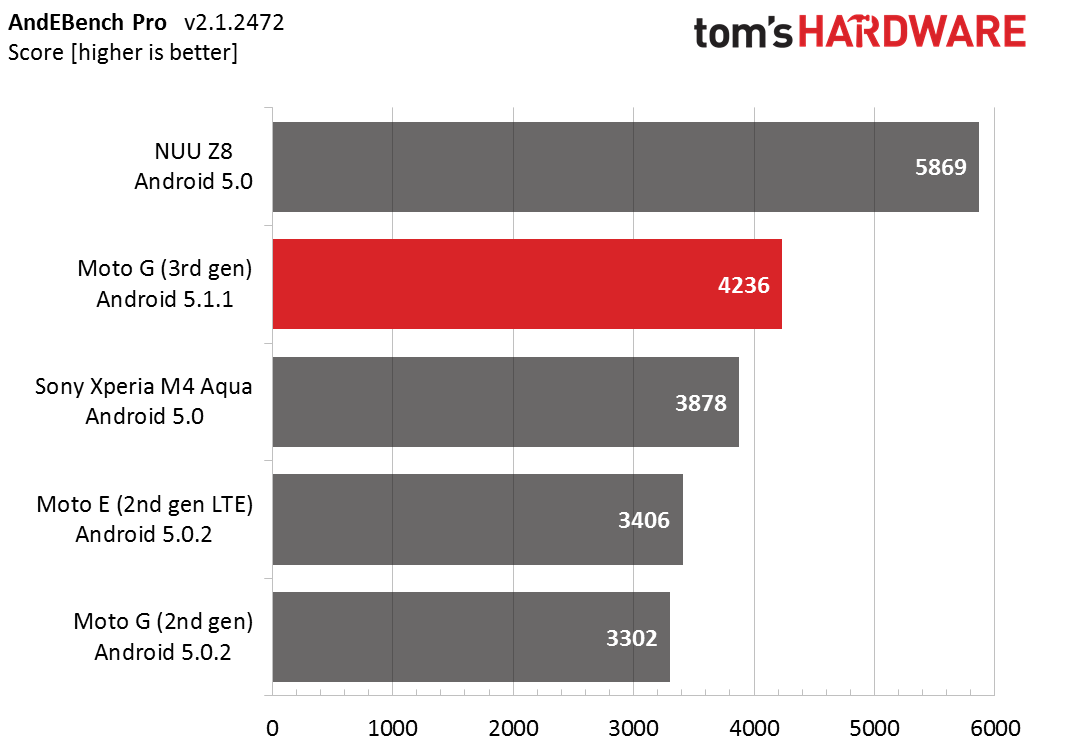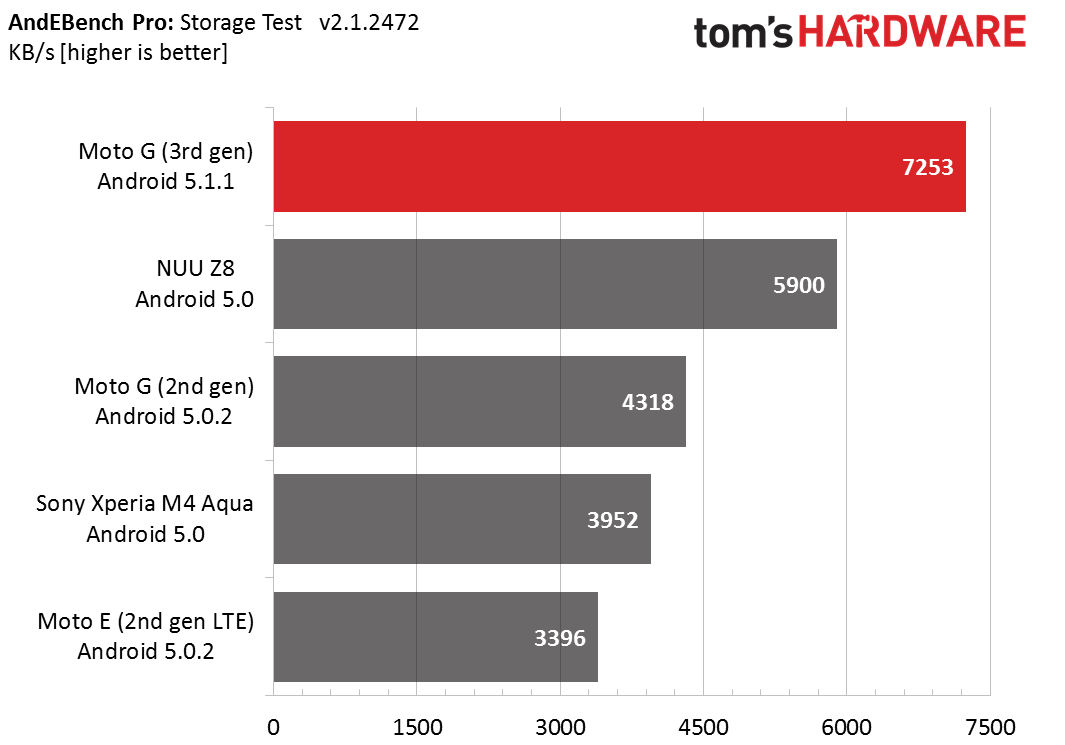Motorola Moto G (3rd gen) Review
Why you can trust Tom's Hardware
CPU And System Performance
In this section, we evaluate system-level performance by running a series of synthetic and real-world workloads, along with some browser-based Web tests. There are several facets to overall device performance, including single- and multi-threaded CPU performance, memory and storage speed, and GPU rendering, all of which will be probed by our suite of benchmarks. If you're interested in learning more about how these benchmarks work, what versions we use, or our testing methodology, please read our article about how we test mobile device system performance.
Most of the devices we’ll be comparing are using ARM’s Cortex-A53 CPU cores. However, there are differences in core count, clock speed, and GPUs. Both the Moto G (3rd gen) and Moto E LTE (2nd gen) are using Qualcomm’s Snapdragon 410 SoC. The older, second generation Moto G uses a Snapdragon 400 SoC, which uses lower-performing Cortex-A7 CPU cores. While the Snapdragon 400 series is based around a quad-core CPU configuration, the MediaTek MTK6752 inside the NUU Z8 and the Snapdragon 615 inside Sony’s Xperia M4 Aqua are octa-core SoCs.
With both the Moto G (3rd gen) and Moto E (2nd gen) using the same Snapdragon 410 SoC, it’s no surprise to see them perform similarly in the System and Graphics tests. The new Moto G’s A53 CPU cores give it a 36% advantage over the previous Moto G’s A7 cores in the System test. It also performs up to 26% better than the Moto E and its predecessor in the Web test, which suggests the third-generation Moto G holds a memory bandwidth advantage over the Moto E. Because the System test probes both single- and multi-threaded CPU performance, the NUU Z8’s four extra cores give it a significant advantage over the Moto G. Curiously, the Xperia M4 Aqua’s eight cores go underutilized, performing no better than the Moto G’s quad-core SoC.
Turning to the Graphics test, the Adreno 306 GPU in the Moto G (3rd gen) and Moto E (2nd gen) ends up being a slight downgrade from the Adreno 305 in the older Moto G. While the architectural differences are likely minimal, the older GPU actually has a 12.5% advantage in clock speed. Both the Z8 and Xperia M4 Aqua easily outperform the three Moto’s in GPU performance.
The Memory test results are a little misleading without some explanation. The test is supposed to measure internal NAND storage performance, but because of the way the test is designed, this does not always happen. We’ve found that for devices with only 1GB of RAM, like the second-generation Moto E and Moto G, the Memory test does seem to measure storage performance. However, for devices with 2GB of RAM or more, including the Moto G (3rd gen), NUU Z8, and Xperia M4 Aqua, the operating system caches disk I/O in RAM before writing the data to NAND in order to improve performance. This accounts for the large disparity in Memory performance between these two groups, and also highlights a non-obvious advantage to having more than 1GB of RAM in an Android phone.







Overall, the Moto G (3rd gen) does well, posting a 28% improvement over the previous generation. It even manages to outperform the theoretically faster Snapdragon 615 equipped Xperia M4 Aqua.
With the cpu-centric CoreMark-HPC test, we see results similar to the Basemark OS II System test. Namely, the Z8’s eight CPU cores gives it the advantage in these multi-threaded scenarios. We also see the Moto G (3rd gen) outperform the older Moto G by a similar 32% margin.
Get Tom's Hardware's best news and in-depth reviews, straight to your inbox.
Memory performance is another differentiator for the third-generation Moto G. It offers a large 68% increase in memory bandwidth over the previous generation and a more modest 10% advantage over the Moto E, confirming our suspicion that the Moto E is using less expensive RAM with lower performance. The more expensive Z8 offers an additional 25% throughput over the Moto G.
It’s nice to see that Motorola is also using decent quality NAND, boosting the new Moto G’s internal storage speed to levels similar to more expensive mid-range phones. The 68% improvement over the previous generation results in noticeably quicker app load times.
The AndEBench Pro Platform test uses a realistic workload that stresses CPU, memory, and storage performance, and is more indicative of everyday performance. It’s encouraging then to see the Moto G (3rd gen) top the chart with a substantial 63% improvement over the last generation. Faster memory and storage performance also gives it a clear edge over the cheaper Moto E.


In the single-core test, the Z8 pulls ahead of the Moto G (3rd gen) by 52% despite having only a 24% advantage in max CPU frequency. The Z8’s 64-bit capable operating system and its ability to harness the new features introduced in the ARMv8 architecture, particularly the additional instructions for speeding up cryptography, is the source for this extra performance. Both the Moto G and Moto E run 32-bit versions of Android, so they miss out on these performance enhancements.
With twice as many CPU cores, the Z8 and Xperia M4 Aqua widen their lead over the Moto G in the multi-core test. However, with most apps being single-threaded and rarely more than four cores active at any one time during normal use, these results are mostly just for bragging rights.


PCMark is the best test we currently have for predicting real-world performance. The CPU governor, which controls how many cores are active and at what frequency they run at, has a significant impact on overall performance, whether searching your inbox or just scrolling in a Web page or the app drawer. The PCMark results are generally a good indicator of how each OEM tunes the CPU governor, trying to balance performance and battery life.
The Moto G (3rd gen) performs well overall, just like we saw in the AndEBench Pro Platform test, essentially tying the Z8 for top honors and outpacing the older Moto G by a noticeable 30%.
Diving into the individual test scores, the Moto G (3rd gen) achieves the highest score in the Writing and Video Playback tests and is second only to the Z8 in Web Browsing. In these tests, the Moto G routinely keeps four CPU cores online running at or near peak frequency. The Z8 in contrast generally utilizes only two cores and maintains them at a lower average frequency.



These browser benchmarks gauge JavaScript performance and are influenced by CPU speed and memory bandwidth. Once again the Moto G (3rd gen) does well, consistently outperforming the previous generation by a large margin, but falling a little behind the Z8.
After a litany of tests, it’s safe to say that the Moto G (3rd gen) offers a significant performance improvement over the previous generation. Max CPU performance increases by about 35% on average and both memory bandwidth and internal storage speed increase by almost 70%. These gains are noticeable in everyday use too, and hold up well even when compared to more expensive mid-range devices.
Lucian Armasu is a Contributing Writer for Tom's Hardware US. He covers software news and the issues surrounding privacy and security.
-
MasterWandu Just got the 16GB phone. Best value for money phone I have ever owned. Cannot believe the quality / specs at the price point. It's about as quick / specc'ed as my Nexus 4 that it replaces, but it trumps the Nexus 4 with it's expandable memory and 4G/LTE capabilities. Couldn't recommend it more!Reply -
gangrel I don't game on my phone, so that's never been an issue for me. I do note that app install speeds are very good; download speed I can't really say, as I do all of that on wifi, not cell. I'm quite happy with it.Reply -
Glock24 Why is the ZenFone 2 listed in the specs / comparison table , but not on benchmarks? It's $20 cheaper than the Moto G 16GB/2GBReply -
MattBoothDev Only issue is it released a couple of months ago, but isn't getting Marshmallow. Bit poor, that.Reply -
RCFProd Reply16943558 said:Only issue is it released a couple of months ago, but isn't getting Marshmallow. Bit poor, that.
it is getting Marshmallow no?
http://www.androidstandard.com/android-m-will-hit-moto-g-3rd-gen-and-2nd-gen-in-this-fall/ -
ZolaIII Not impressed. There are similar spec Chinese phone's with more than 2x lower price like for instance Elephane Trunk. I know it's weird Elephone made a decent phone but strange things happen. As much as Motorola got a developer community and long suport it's not worth 2+x.Reply -
MobileEditor ReplyWhy is the ZenFone 2 listed in the specs / comparison table , but not on benchmarks? It's $20 cheaper than the Moto G 16GB/2GB
There are two different versions of the ZenFone 2 (well more if you count the special editions). The less expensive version is shown in the spec table since it's closer in price to the Moto G. We only tested the more expensive version with a faster SoC, so that's why it's not in the benchmark charts. Plus, we already included the more expensive/faster Z8 as the upper bound in the charts. I figured this was more relevant, since it has a more common SoC configuration.
- Matt Humrick, Mobile Editor, Tom's Hardware



